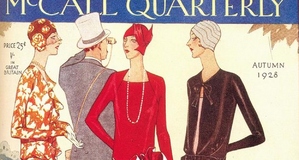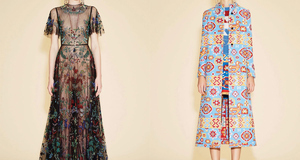Featured Article:Women's Fashion and the Renaissance: Considering Fashion, Women's Expression, and Sumptuary Law in Florence and Venice
By
2013, Vol. 5 No. 10 | pg. 3/3 | « "Nature Deems It Inappropriate"In Florence’s 1433 sumptuary law, the reasons for the law are outlined thus: “Women are unmindful that nature deems it inappropriate for them to adorn themselves with such sumptuous ornamentation … which cause manly vigor to fail” (In Hughes, 1992, p. 142). While nature may not have actually deemed contemporary fashions inappropriate, the municipal governments certainly did. Italian sumptuary law was “more frequent, wide ranging, and detailed” than the laws of other regions in Europe. Neither Florence nor Venice passed the first sumptuary law (that title goes to Genoa in 1157), but it did not take them long to catch onto the trend, passing their first laws in 1281 and 1299, respectively (Killerby, 2002, p. 23; 28-29). Venice’s laws seem overall more concerned with the copious sums of money “converted into vanities,” as a Venetian law of 1360 recorded, while Florence’s laws are more commonly couched in moral terms. In both cases, a fear of social disorder seems to be the origin of the concerns (Hughes, 1983, p. 77; 90). Regardless of the alleged reasoning behind the laws, a preoccupation with the regulation of women’s clothes is particularly evident across the Italian peninsula. Between 1200 and 1500, laws regulating women’s clothes accounted for around 135 laws whereas laws regulating men’s clothes amount to approximately twenty-five, laws regulating peasants’ clothes amount to approximately five, and laws regulating feasts amount to approximately twenty (Killerby, 2002, p. 38). At least on some level, such volume was the result of fashion’s constant changes: by the time legislators had passed a law, a new fashion had already taken over, perhaps a deliberate move by the city’s women (Frick, 2002, p. 183). While initially legislators passed sumptuary laws at approximately the same rate for both sexes, over time the laws began to target women more often, almost exclusively (Killerby, 2002, p. 112; Laufenberg, p. 5). Tellingly, the office charged with prosecuting offenders of either sex was known as the Ufficiali delle donne, the “Officials on Women” (Rainey, 1991, p. 218-19).The majority of Florentine laws regulated female ornamentation. Still others regulated the size of a woman’s wardrobe: Florentine statutes of 1322-1325 limited women to four dresses for wearing in public, only one of which could be red (Rainey, 1991, p. 219), a rather draconian standard in light of Carole Frick’s estimate that adult wardrobes typically included twenty to twenty-five pieces, excluding linens (2002, p. 167). Many more laws aimed to limit the quantity and value of rings and headpieces, though unmarried women could wear as many rings as they wished. Materials for metallic ornaments and trims were restricted. Trains could only flow so long; necklines could only plunge so deep; sleeves could only fan so wide. Foreign fashions, too, were restricted (Rainey, 1991, p. 219-20). Venetian sumptuary law seems to have followed similar overall patterns.6 The desire to regulate modesty in clothing appears throughout sumptuary law. The preamble to a 1420 Florentine law highlights such concern with female modesty: “Considering that the ornament of modesty, which is the chief ornament of woman, is removed by excess in apparel…” (Killerby, 2002, p. 116-18). Unsurprisingly, women were most restricted by sumptuary law when sexually mature, but unmarried and when married, but childless (Hughes, 1983, p. 94). Perhaps most troublesome for the Renaissance woman was the connection between women’s desire for clothing and Eve’s Original Sin. Clothing did not, after all, exist before Eve’s sin. Thus, women were reenacting Eve’s sin by tempting men to buy more clothing. Giovanni Villani’s words echo this fixation with Original Sin and seem to speak as much about Adam as about Renaissance men: “…and thus the immoderate appetite of women conquers the reason and good sense of men” (Killerby, 2002, p. 118; 111). Women did not willingly accept their favored place in sumptuary law, nor were they alone in their resistance. During Ser Donato’s six-month term as the notary of the executor of the Ordinances of Justice in Florence, he recorded two instances of men impeding his attempts to write up reports on women in violation of sumptuary law, one of which may have turned violent. Though men were ostensibly responsible for the fees assessed to women wearing an offending garment, this does not account for the actions of these men because such fines could later be taken out of a woman’s dowry either when she married or when her dowry was returned to her as a widow. Women in Florence also seem to have made a point of avoiding the Ufficiali delle donne when they knew he was out, escaping into churches or other “safe zones” (Frick, 2002, p. 182-83). If caught, women were scarcely helpless, though such resistance caused them to forfeit the opportunity for a full hearing (Laufenberg, p. 9): Franco Sacchetti marveled at the women of Florence’s ability to be excellent “logicians” in avoiding prosecution (Rainey, 1991, p. 221-25). In many instances, women seem to have invented certain avoidance terms or used otherwise evasive language. In one instance, a woman insisted that she was not wearing ermine, but “lattizi,” a term that translates as “milky,” “e una bestia,” “and a beast” (Frick, 2002, p. 189). In a similar instance, a woman declared she was not wearing ermine, but “suckling.” When the official asked what a suckling was, she answered evasively, “It is an animal.” In yet another instance, Franco Sacchetti reported a woman accused of having a peak with fringes, doffing the peak and declaring it a wreath (Hughes, 1983, p. 69-70). Those women who were apprehended in some cases even defended themselves in legal proceedings: in 184 cases from the 14th century, women answered the charges against them personally, though this became less common over time (Laufenberg, p. 16-17). Finally, in the case of Venetian women, petitions to the pope, as previously mentioned, did, on occasion, appear (Killerby, 1999, p. 256). ConclusionFashion filled a very specific need in the life of the typical Renaissance woman who, unlike Laura Cereta, lacked an outlet for expression and a way by which to define herself. With fashion, women could craft an image to project to society. The unique characteristics of Italian society—specifically, the republican nature of its governments and the greater level of social alienation for women compared with other European cultures—allowed fashion to flourish in ways it did not and could not in other societies. Unsurprisingly, these same unique characteristics also came to define Italian sumptuary law. The sumptuary laws of the Italian peninsula reflect a society that though not bound by a need to preserve its strict hierarchical social stratification, was bound by a need to preserve a status quo that involved an overwhelmingly marginalized female sex. Women’s attempts at resistance were, then, part of an understandable struggle for a voice. ReferencesAlberti, L.B. (1969). The family in Renaissance Florence (R.N. Watkins, Trans.). Columbia, SC: University of South Carolina. Allerston, P. (2000). Clothing and early modern Venetian society. Continuity and Change, 15(3), 367-90. Barbaro, F. On wifely duties. In The civilization of the Italian Renaissance: A sourcebook (pp.151-53). The civilization of the Italian Renaissance: A sourcebook. (1992). K.R. Bartlett(Ed.). Lexington, MA: D. C. Heath. Belfanti, C.M. (2009). The civilization of fashion: At the origins of a western social institution. Journal of Social History, 43(2), 261-283. doi:10.2307/20685387 Birbari, E. (1975). Dress in Italian painting, 1460-1500. London, UK: J. Murray. Cereta, L. Letter to Augustinius Aemilius, curse against the ornamentation of women. In The civilization of the Italian Renaissance: A sourcebook (pp.192-94). Frick, C.C. (2002). Dressing Renaissance Florence: Families, fortunes, and fine clothing. Baltimore, MD: Johns Hopkins University Press. Hughes, D.O. (1992). Regulating women's fashion. In C. Klapisch-Zuber(Ed.), Women in the west (pp.136-58). Cambridge, UK: Harvard. Hughes, D.O. (1983). Sumptuary law and social relations in Renaissance Italy. In J. Bossy(Ed.), Disputes and settlements: Law and human relations in the west (pp.69-99). Cambridge University. Hunt, A. (1996). Governance of the consuming passions: A history of sumptuary law. New York, NY: St. Martin's. Killerby, C.K. (1999). "Heralds of a well-instructed mind": Nicolosa Sanuti's defense of women and their clothes. Renaissance Studies, 13(3), 255-82. doi:10.1111/j.1477-4658.1999.tb00077.x Killerby, C.K. (2002). Sumptuary law in Italy 1200-1500. Oxford, UK: Oxford University Press. Laufenberg, L.M. (n.d.). Regulating the ‘indecent and superfluous ornaments of women’: Sumptuary laws in fourteenth-century Florence. O'Malley, M. (2010). A pair of little gilded shoes: Commission, cost, and meaning in Renaissance footwear. Renaissance Quarterly, 63(1), 45-83. doi:10.1086/652533 Rainey, R. (1991). Dressing down the dressed-up: Reproving feminine attire in Renaissance Florence. In J. Monfasani, & R.G. Musto(Ed.), Renaissance Society and Culture (pp.217-37). NY: Italica. Endnotes1.) Cereta was from the Venetian-controlled city of Brescia. 2.) It is important to note that Diane Owen Hughes (1983) in Sumptuary law and social relations in Renaissance Italy. In J. Bossy(Ed.), Disputes and settlements: Law and human relations in the west (pp.69-99). Cambridge University, p. 85 presents a contradictory chart comparing Bologna, Siena, and Venice, which shows Venice as passing the least sumptuary laws among the three. 3.) Differing arguments appear in Hughes, 1983, p. 84 and Killerby, 2002, p. 119. While Hughes maintains, “Most fifteenth century preambles state explicitly that women are the ruin of men,” Killerby rejects this claim by remarking, “of the 300 or so laws examined for this study, only these six overtly misogynistic preambles were found.” Differing views over what constitutes misogyny may be at play. 4.) It is important to note that Birbari draws mostly on Florentine sources about dress, though her study is not necessarily specific to Florence. 5.) Unmarried young women did not wear a cloak over their other layers. 6.) Based on my reading of Hughes, “Regulating” and “Sumptuary,” and Killerby, “Sumptuary.” Suggested Reading from Inquiries Journal
Inquiries Journal provides undergraduate and graduate students around the world a platform for the wide dissemination of academic work over a range of core disciplines. Representing the work of students from hundreds of institutions around the globe, Inquiries Journal's large database of academic articles is completely free. Learn more | Blog | Submit Latest in History |
















